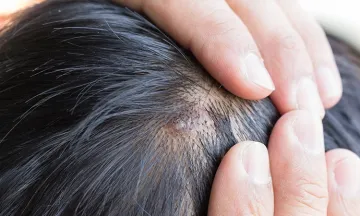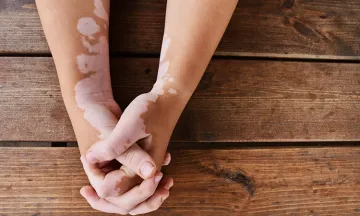Hormonal Imbalances: A Key Cause of Sudden Hair Loss in Men
Experiencing a sudden shower of hair on your pillow or clogging the shower drain can be startling. But what counts as "sudden" hair loss in men? Generally, if you're losing more than 100 hairs a day—noticeably more than your usual rate—it's time to pay attention to male pattern hair loss. This spike in hair shedding could be a sign of hormonal imbalances.
Hormones, like testosterone, can transform into DHT, a substance that is one of the reasons for hair loss in men. This process can shorten the hair growth cycle and shrink hair follicles. It may lead to noticeable hair thinning or bald patches quite quickly.
If you're seeing more hair in your brush or around the house, it might be time to investigate the reasons for hair loss in men and what's happening under the scalp.
Male Pattern Hair Loss
Male pattern hair loss, scientifically known as androgenetic alopecia, is a prevalent condition that affects millions of men worldwide. It changes physical appearance but often influences self-esteem and personal identity.
Male pattern hair loss is primarily driven by genetic predisposition and hormonal influences. It is particularly the interaction of hair follicles with dihydrotestosterone (DHT), a potent derivative of testosterone and one of the causes of baldness in males.
Overview of Baldness Stages
Before you understand what causes sudden hair loss, you need to know that there are seven baldness stages in male pattern hair loss. When you know the reasons for balding and where you stand, you can better manage your hair density and pattern:
- Stage 1: Minimal or no noticeable hair loss. This is a baldness stage. The hairline remains intact, and there are no visible signs of thinning.
- Stage 2: There is a slight recession at the temples, often known as a mature hairline, but it is not immediately noticeable.
- Stage 3: This is the first stage where hair loss in men becomes clinically significant, with noticeable recession at the temples and possibly the beginning of a bald spot at the crown.
- Stage 4: Further hairline recession and enlargement of the bald spot at the crown. Hair thinning becomes more apparent.
- Stages 5 to 7: These stages are characterised by severe male-pattern hair loss, with the bridge of hair dividing the head's top narrowing significantly or disappearing completely.
Causes of Hair Loss in Men
Male pattern hair loss can often feel like an inevitable part of ageing. Here are three primary causes of balding:
Genetic Predisposition
Referred to as male pattern baldness or androgenetic alopecia, genetic predisposition is men's most common cause of hair loss. If your family history includes individuals with hair loss, you're more likely to experience it.
Hormonal Imbalances
Imbalances, particularly in androgens (male hormones), can lead to hair loss. For instance, changes in testosterone levels can directly affect the hair growth cycle.
DHT Sensitivity
DHT is a derivative of testosterone and is critical in developing male characteristics. However, what causes sudden hair loss in men is this. Men with hair follicles that are genetically sensitive to DHT will notice that over time.
Hormones and Hair Loss Mechanisms
Role of Testosterone and DHT
Testosterone, when converted into DHT, can also contribute to male-pattern hair loss. This conversion process, catalysed by the enzyme 5-alpha-reductase, increases DHT levels, which attach to hair follicles and shrink them.
Impact of Hormonal Changes
Beyond DHT, other hormonal changes, like those during thyroid disorders or sudden hair loss stress, are also causes of hair loss in men. For instance, high stress can elevate cortisol levels. It may push more hair follicles into the resting phase, where they don't produce new hair.
Thyroid Disorders and Hair Loss
Thyroid disorders, both hyperthyroidism and hypothyroidism, can also be one of the causes for hair loss in men due to the way they disrupt hormone production and regulation. These conditions speed up or slow down metabolism, which can accelerate the conversion of testosterone to DHT.
Factors Contributing to Balding in Males
Here's a detailed look at some of the key causes of balding:
Ageing and Hair Thinning
As men age, their hair follicles shrink due to hormonal changes, particularly from decreasing testosterone, which turns into dihydrotestosterone. DHT attacks hair follicles, causing thinner hair and eventual hair fall.
Stress and Sudden Hair Loss
Physical or emotional stress can trigger conditions like telogen effluvium, where hair shifts faster from the growing phase to the resting phase and then falls out. Fortunately, this type of hair loss male is usually temporary, and sudden hair loss stress management techniques can reverse its effects.
Lifestyle and Environmental Factors
Poor diet, lack of nutrients, and smoking are also causes of balding. They can contribute to weaker hair follicles. Moreover, exposure to pollutants and harsh hair care products can exacerbate hair thinning. Maintaining a nutritious diet rich in vitamins and minerals and using gentle hair care products is advised.
Managing Hormonal Imbalances and Hair Loss
Managing hormonal imbalances to prevent causes of baldness in males often requires a two-pronged approach: medical treatments and lifestyle adjustments.
Medical Treatments
Medical treatments like finasteride and minoxidil are effective in combating male pattern hair loss, especially from hormonal imbalances. These medications directly target the hormones that cause hair thinning.
Lifestyle Adjustments
Small yet impactful changes can make a major difference on the lifestyle front.
- Maintain a rich diet in antioxidants and minerals
- Engage in regular strength training to naturally boost hormone production
- Ensure adequate sleep while managing stress with meditation or yoga.
Preventing and Slowing Hair Loss
Preventing and slowing hair loss involves more than choosing the right shampoo; you must start scalp care and hair maintenance.
Scalp Care and Hair Maintenance
Firstly, maintaining a clean scalp is crucial in preventing DHT build-up. Shampoos specifically formulated to reduce DHT levels and promote scalp health can be highly effective. Look for ingredients like ketoconazole or saw palmetto.
Avoiding DHT Build-Up
Consuming foods high in fibre and low in sugar supports gut health and is linked to balanced hormone levels. Incorporating foods rich in vitamin D, zinc, and omega-3 fatty acids helps testosterone production and maintain hormonal balance.
Regular Scalp Massages
Regular scalp massages should also be part of your hair care regimen. These massages stimulate blood flow to the scalp, nourishing hair follicles and fostering growth.
Consult a Hair fall expert now!
Are you noticing early signs of baldness? If yes, you should not ignore them because they could lead to permanent male pattern hair loss. Consult a hair fall expert today to understand the reasons for hair loss in men, prevent further damage, and restore your hair's health.
Seeking professional advice can offer you personalised treatments that promote hair regrowth, maintain your existing hair, and boost your confidence. An expert can help you understand what causes sudden hair loss, pinpoint the cause of hair loss in males and provide effective solutions.
Don't wait until it's too late. Take control of your hair health now and enjoy the lasting benefits of a full, vibrant head of hair!



